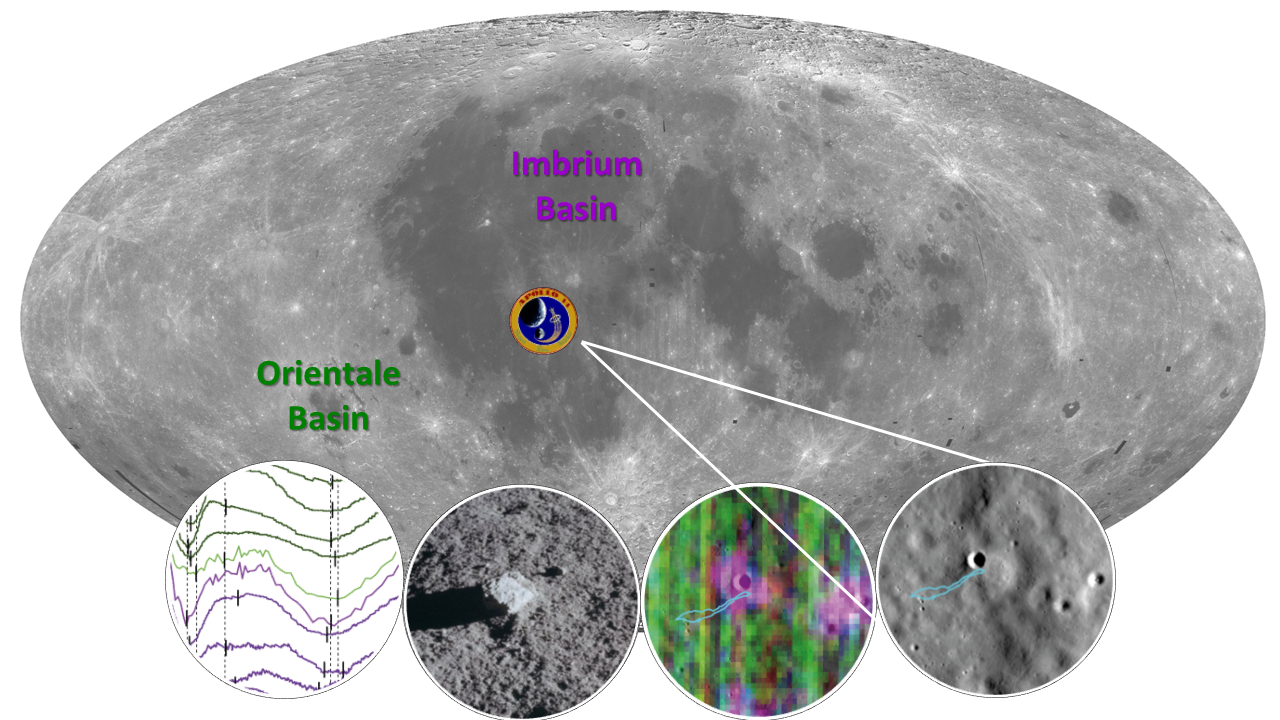The Apollo 14 mission was the third crewed mission to the Moon. It landed on the near side of the Moon – within the volcanic plains region (red region of Figure 1), and which was the intended site of the aborted Apollo 13 mission a year prior. Within this region is the Imbrium Basin – the largest impact basin on the Moon, which is thought to have delivered ejecta (impact rock and sediment redistributed during the basin formation) to most areas of the lunar surface.
The Imbrium Basin ejecta has long been studied, including remotely, via early telescope observations, and directly, from rock samples collected by several Apollo mission crews. Various rock samples from different sites of the Moon were found to be of similar composition and the same age, and therefore supposedly dated Imbrium’s formation.
CEED Professor and leader of the “Earth and Beyond” Group, Stephanie Werner, and her team revisited the Apollo 14 landing site. Not physically, but using new image and spectral data. Reflected light from the surface of the Moon, when split into different wavelengths, allows for the identification of rock-forming minerals from space. Colour-coded maps illustrate where a specific mineral is detected, for example, green in the inset (Figure 2) indicates the likely presence of feldspar – a mineral typical for the pale highlands of the Moon. This detection revealed that it could not be only Imbrium rocks at the Apollo 14 site. Instead, the spectral analysis suggested two layers of material, and the more the team looked into it, the more it became evident that the thin top layer is the ejecta material from another basin – the youngest lunar basin on the Moon – Orientale.

The Orientale Basin formed 3.92 billion years ago, 200 million years earlier than commonly believed. The new findings by Werner and colleagues are important because they therefore re-date and re-attribute many lunar surfaces, i.e. which were previously attributed to the Imbrium event. The materials collected by the astronauts, therefore reflect a very different origin from the highlands, a thousand kilometres further away than previously thought.
Furthermore, the study now suggests that Orientale (the youngest lunar basin), also now marks the onset of recorded mare volcanism; previously the timing of the Orientale impact (and basin formation) and mare volcanism were rather unclear. Lunar thermal history models and timescales must therefore be revised so that the feldspathic highland crust underwent significantly more and later thermal modifications than previously thought. Furthermore, the study suggests that the intensity of impact bombardment 3.9 billion years ago was much lower (by a factor of three). This is not only important for the Moon – but also suggests that the Earth was a more liveable place at that time than previously thought.
The implication of the new study challenges three longstanding paradigms of lunar and early solar system research: 1) the age of Imbrium; 2) rocks with especially high content of potassium, rare Earth elements and phosphorous (K REE P) relate to mare volcanism (which form the darker regions of the Moon); and 3) a spike in the impact flux (so-called Late Heavy Bombardment). Werner states “these three concepts are ready for abandonment”.
Contact information – Stephanie Werner (Stephanie.Werner@geo.uio.no).
Publication details - Stephanie C. Werner, Benjamin Bultel, Tobias Rolf and Vera Assis Fernandes. 2022. Orientale Ejecta at the Apollo 14 Landing Site Implies a 200-million-year Stratigraphic Time Shift on the Moon. The Planetary Science Journal v3. https://iopscience.iop.org/article/10.3847/PSJ/ac54a6





